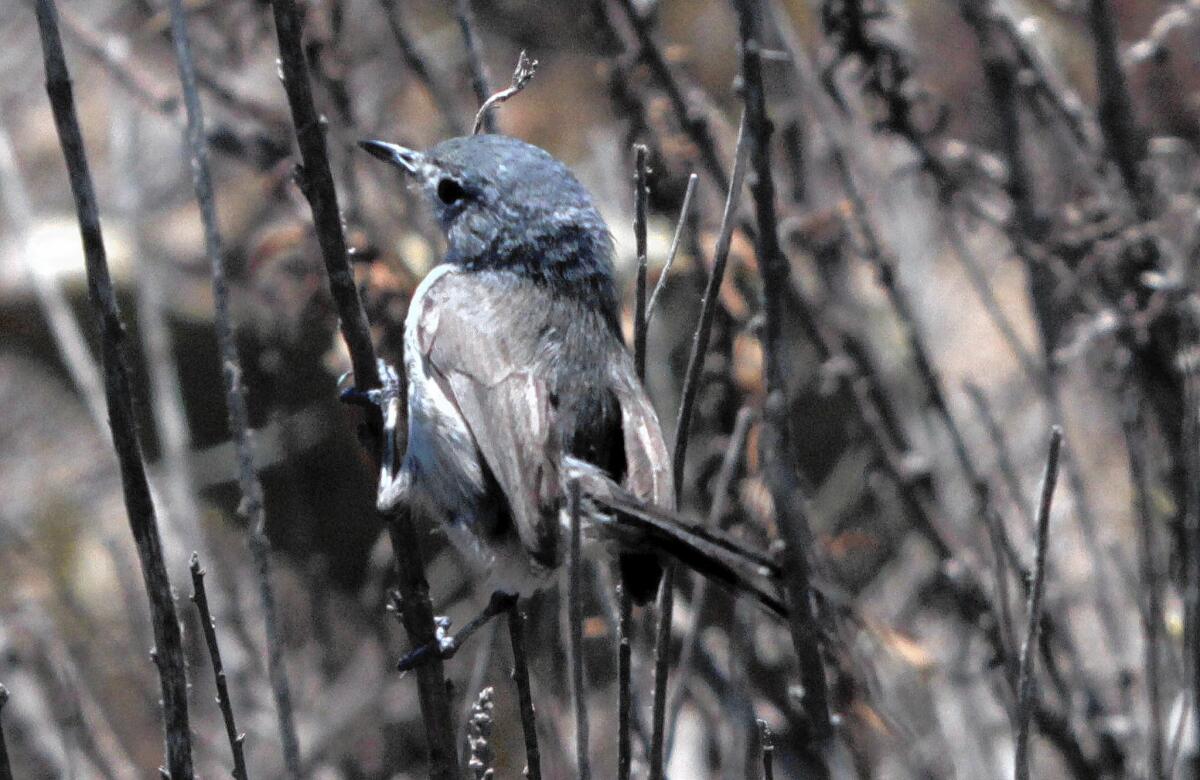Developers seek end to federal protections for California gnatcatcher

Developers citing new scientific evidence are pressing to end federal protections for the California gnatcatcher, whose status as a threatened species has barred development in many areas of prime Southern California coastal real estate for two decades.
Developers argue that DNA analyses show that the coastal California gnatcatcher is no different from other gnatcatchers flourishing from the Palos Verdes Peninsula to the southern tip of Baja California.
If the U.S. Fish and Wildlife Service agrees, it could remove federal protections it extended to the bird in 1993 — opening the way to development on an estimated 197,000 acres of largely coastal land in Los Angeles, Orange, San Diego, Ventura, Riverside and San Bernardino counties.
That land was designated as critical habitat for the California gnatcatcher after it was deemed a threatened species, a step that touched off a furious debate. To some, the designation was a triumph of environmental law. To others, it was misguided overreach.
“If we win, it could put an end to this rather sorry story of bullheaded devotion to a determination that is just not defensible,” said Damien M. Schiff, principal attorney at the Pacific Legal Foundation, which represents the petition filed by groups including the California Building Industry Assn. and the Property Owners Assn. of Riverside County.
Environmental organizations said the new evidence is insufficient and does not explain differences in appearance between the California and other gnatcatcher species. They conceded, however, that they have no DNA evidence to support their belief that the California gnatcatcher is unique.
The developers’ petition is based on DNA analysis by a team of scientists led by Robert Zink, a professor of biology at the University of Minnesota, and George Barrowclough, associate curator of ornithology at the American Museum of Natural History in New York.
They concluded that the bird is not a distinct subspecies. Their peer-reviewed conclusions were published last year in The Auk, a scientific journal and the official publication of the American Ornithologists’ Union.
It was Zink’s second such finding about the bird. In 2010, the Pacific Legal Foundation filed a petition based on his earlier DNA analysis, which was conducted on mitochondria in gnatcatcher cells. The Fish and Wildlife Service turned down that petition but did not dispute the findings.
Instead, the agency suggested that it wanted analysis to go beyond mitochondria to examine DNA in the nucleus of gnatcatcher cells. Zink’s latest analysis is of DNA in cell nuclei.
Designation of the California gnatcatcher as a separate subspecies “was based on qualitative judgments and early 1900s technology — basically the equivalent of calipers and pencils,” Zink said. “There was no genetic data at that time.”
Zink’s findings do not sway supporters of protecting the California bird’s separate status. Doubters include Sylvia Fallon, a geneticist and director of the Natural Resources Defense Council’s Wildlife Conservation Project.
Fallon said the absence of genetic differentiation may reflect inadequate sampling of the organism’s genome and, therefore, should not outweigh other biological evidence of differentiation such as color of plumage, size and tail length.
The California gnatcatcher is similar to the black-tailed gnatcatcher but with a darker gray breast. The California bird also has a less distinct eye ring, and less white in its outer tail feathers, than the black-tailed gnatcatcher.
Michael Patten, a geneticist at the University of Oklahoma, argued that Zink is “philosophically opposed to the very notion of ‘subspecies’ and therefore should be recused from cases such as this one.” Patten suggested that Zink’s analysis “was incomplete and only accounts for a tiny fraction of the whole genome.”
Zink strongly disagreed. “To say we didn’t look hard enough is insulting,” he said. “We tested it with modern methods.”
“If a bird does not have genetic differences, it doesn’t exist” as a separate species, said Zink, who is also curator of birds at the University of Minnesota Museum of Natural History.
Part of the funding for the research was provided by “the Southern California building industry,” Zink said.
“Yes, they have a dog in this fight, but the university would not accept funding if the DNA study got money from sources they consider tainted,” he added. “They did not influence the research or the writing of the study.”
Developers say they hope Fish and Wildlife will make a decision by the end of the year.
Unlike some other endangered species whose habitats are in areas largely considered unfit for development, the California gnatcatcher nests largely in coastal areas that are ripe for construction, with panoramic views of the Pacific Ocean.
Just 41/2 inches long, the lively birds are year-round residents of peninsula habitats with coastal sage scrub, a plant community dominated by sagebrush, buckwheat, coyote brush, lemonade berry and beaver-tail cactus.
Throughout Southern California, particularly in Orange and San Diego counties, “gnatcatcher wars” stalled building projects for several years until agreements in the mid-1990s created preserves of tens of thousands of acres to protect the habitat where the birds nest almost exclusively.
By that time, however, the birds had been pushed out of almost all of their ancestral range by urban development, golf courses and fires. Today, an estimated 2,500 California gnatcatchers remain in the United States, federal wildlife authorities said.
Twitter: @LouisSahagun







